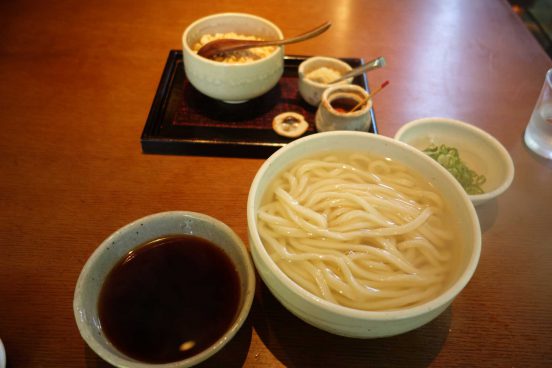From soba, I went on to udon. And tempura. And a revelation.
The neighborhood:
Nezu. Small alleys, low buildings, it is a place of normal life, of ordinary people, giving Tokyo the village-vibe it does have, but normally just in the mixture of different neighborhoods.
The building:
An old, refurbished kura, the former storehouse of a wealthy merchant. The two dining areas are in a new glass-walled extension at ground level that almost feels a part of the garden in front of it, and up a few stairs from there, inside the old storehouse.

In the extension, one sits and eats at a long communal wooden table, in the storehouse area, the setting is Japanese, with a polished floor (that you enter only after having stepped out of your shoes at the foot of the stairs, of course, and sitting on zabuton cushions at the low tables, with space to stretch your legs underneath).
The food:
Udon, the thick, white wheat noodles that are rather less common in Tokyo than in other parts of Japan. (The origins of Kamachiku are, in fact, in Osaka.)
They are available either as cold zaru-udon or hot kama-age udon, coming on a bamboo dish or in the water out of which they are to be taken, with the sauce and toppings on the side. The sauce is a wonderfully umami, but not too strong, dashi broth; the toppings are dama-age tempura batter flakes, slices of negi (Welsh onion), and grated ginger.

Of course, there is also shichimi, the 7-spice mixture based around chilli, that is fast becoming a major interest of mine…
Add the additions you’d like to have, preferably one after the other, starting with the tempura flakes, then going on to negi, to ginger, and eventually to shichimi, ‘grab’ some noodles and put them into the broth with the additions (or slide them over more carefully), and enjoy:

The side dishes on offer are not many, either, but of a quality that is a revelation.
I got a chance to try the satsuma-age, the fried fish cake, thanks to a friendly Japanese couple next to me. It was an interesting mix of slightly crunchy and creamy, with a bit of citrus on the side that added a very unusual but good acidic-fruity note.
My main aside, however, was tempura – which stole the show.

Crunchy, extraordinarily fresh, and served the uber-traditional way with just a little heap of salt. A salt making me wish I knew what exactly it had been.
Normally, with all the food trends of Pink Himalayan and Blue Persian and what-not salt, I’m a bit annoyed given that it’s all ultimately just sodium chloride. (Yes, I know, it must be strange that someone arguing for a wider recognition of the diversity of chile peppers and other spices hasn’t gotten into the diversity of salts, but I just feel/fear that it is quite a ripoff, all too often.)
This salt, with this tempura, however… It was a revelation.
Hardly ever have I eaten anything that was so simple, so purely itself – and so, so good.
Not my thing, but they also have a selection of sake that ranges far and wide.
Basic Information
Nezu Kamachiku
(in Japanese: 根津釜竹)
Price range: 1000-2000 JPY (Ganzes Abend-Menü 3500-5000 JPY)
Hours:
Mo – Sa 11:30 am – 2:30 pm, 5:30 pm – 9:00 pm
Su and holiday 11:30 am – 2:30 pm
Monday closed
Last order 30 minutes before close, but note that they will also close when the last of the udon prepared for the day is sold!
Reservation for weekday dinner is possible, so are reservations for whole course of foods (two days or more in advance). Count on your having to wait.
Website, also available in English version: http://kamachiku.com

Leave a Reply
You must be logged in to post a comment.